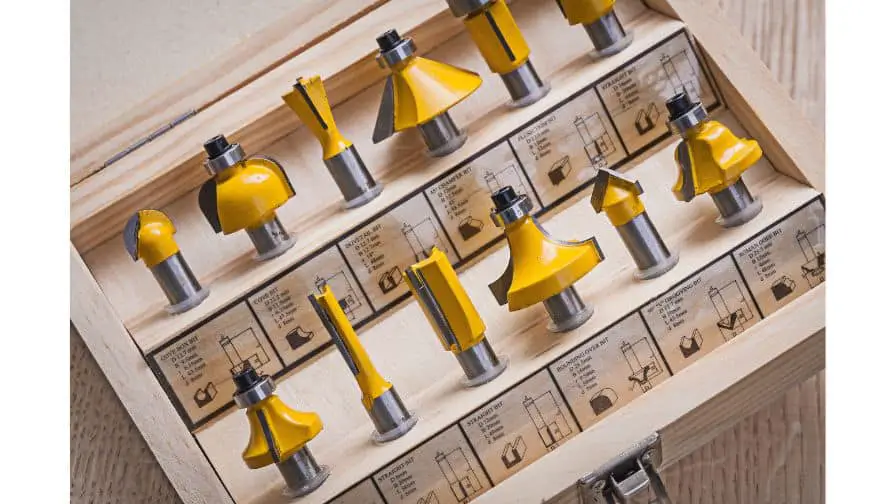
Do you know the difference between a chamfer bit and a roundover bit? If not, don’t worry! You’re not alone. Many people are confused about the two, and it can become tough to tell them apart.
In this blog post, we will discuss the differences between chamfer bits and roundover bits. We will also give you tips on which one is right for your project. So, let’s get started!
What Is A Chamfer Bit And What Does It Do?
A chamfer bit is a tool used to create beveled or slanted edges on a piece of wood. This type of bit is in router tables and can create decorative edges on furniture or trim. Chamfer bits come in a variety of sizes and angles. It’s important to choose the right size bit for the job at hand. Use the proper router speed to avoid burning the wood.
Chamfer bits are also wonderful for breaking edges on a workpiece! This can come in handy when working with delicate or fragile materials that might break if routed with a standard straight bit.
Subscribe to Timbecon on YouTube
What Is A Roundover Bit And What Does It Do?
A roundover bit is a type of router bit to create smooth and rounded edges on woodworking projects like furniture and cabinets. These bits can also generate decorative edge profiles on molding and trim.
This type of bit can produce a variety of edge profiles, from simple roundovers to more complex ogee and cove. Roundover bits are available in diverse sizes and shank diameters to fit several router models.
Subscribe to buildsomething.com on YouTube
How Do You Choose Between A Chamfer Bit vs. A Roundover Bit?
There are two main types of router bits – chamfer bits and roundover bits. Both can function to construct distinct kinds of edge profiles on your workpiece. So, how do you choose between the two?
Chamfer bits have a V-shaped cutting edge that is good for creating sharp and clean 90-degree angles. Roundover bits, on the other hand, have a rounded cutting edge that suits softer and more organic shapes better.
If you’re unsure of which type of bit to use, it’s best to experiment with both! Observe which one grants you the results you’re looking for.
When Should You Use A Chamfer Bit Vs Roundover Bit
You might be wondering when you should use a chamfer bit vs roundover bit.
Here are tips to help you decide.
If you’re looking to make sharp and clean 90-degree edges, then a chamfer bit is the way to go. Chamfer bits also come in handy if you need to quickly remove sharp edges from a project.
Roundover bits, on the other hand, look better for initiating smooth and curved edges. If you’re looking to add a bit of decoration to your project, then opt for a roundover bit. Also come up with raised edges, which help prevent chipping.
What Does A Roundover Bit Look Like?
If you’re not familiar with roundover bits, they are router bits to fashion a rounded edge on a piece of wood. These bits come in various sizes and can turn out multiple shapes and styles of edges. Roundover bits come from carbide or high-speed steel and have a rotating cutting edge on the bottom of the bit. The cutting edge is what routes or carves out the wood as it spins.
Roundover bits have a cylindrical barrel with a pointed tip. The size of the cutting edge will determine the size and shape of the edge it produces. Roundover bits come in many sizes, but the most common are ¼ inch, ½ inch, and ¾ inch.
What Does A Chamfer Bit Look Like?
Chamfer bits look like small and cone-shaped drill bits. They design beveled edges on wood and metal surfaces. Available in a variety of sizes, but the most common size is ¼ inch. Chamfer bits can also come with multiple angles depending on the bevel you want to create. The most common angle is a 45-degree chamfer bit.
Can You Use A Roundover Bit On Plywood?
Yes, you can use a roundover bits on plywood, as long as you take a few precautions. First, make sure the bit is sharp and clean. A dull or damaged bit will cause burning and tear-out. Second, use a slower speed and lighter cuts. This will help prevent the bit from overheating and damaging the plywood.
Roundover bits are one of the most versatile and commonly used router bits. Their ability to build smooth and rounded edges makes them ideal for a variety of applications, from cabinetry to furniture making.
Subscribe to 731 Woodworks on YouTube
How Are Roundover Bits Measured?
Measure roundover bits by their radius, which is the distance from the center of the bit to the cutting edge. The most common radii used for roundover bits are ½”, ¾”, and even full one-inch. The size of the router bit you need depends on the size and scale of your project.
Roundover bits come in two different profiles, bevel and round. Bevel bits have a single and angled cutting edge. Round bits have two cutting edges that are perpendicular to each other. The type of profile you need depends on the type of material you will use the bit on.
Chamfer Vs Roundover For A Cutting Board
If you want a more finished look, go with roundover. If you’re worried about splinters, chamfer the edges.
Chamfering is the process of cutting or shaping a beveled edge on the board. This gives the board a nice and clean look and makes it easier to grip when cutting. Roundover is the process of rounding over the edge of the board. This gives the board a softer and more finished look and can help prevent splinters.
Is Chamfer And Bevel The Same?
No, chamfer and bevel are not the same. The chamfer is an angular cut made on the edge of a piece of wood. A bevel is a sloped surface created by removing material from the edge of a board. Bevel can also refer to the angle itself.
When creating molding, both chamfers and bevels can create interesting profiles and add visual interest.
Chamfers are most commonly cut at 45-degree angles but can have cut at any angle. Bevels are cut at a shallower angle, such as 30 degrees. Chamfers are on the inside corners of molding, while bevels are on the outside corners.




